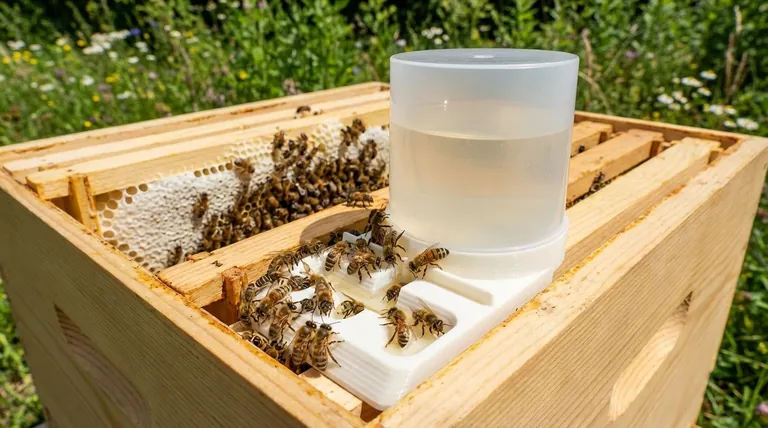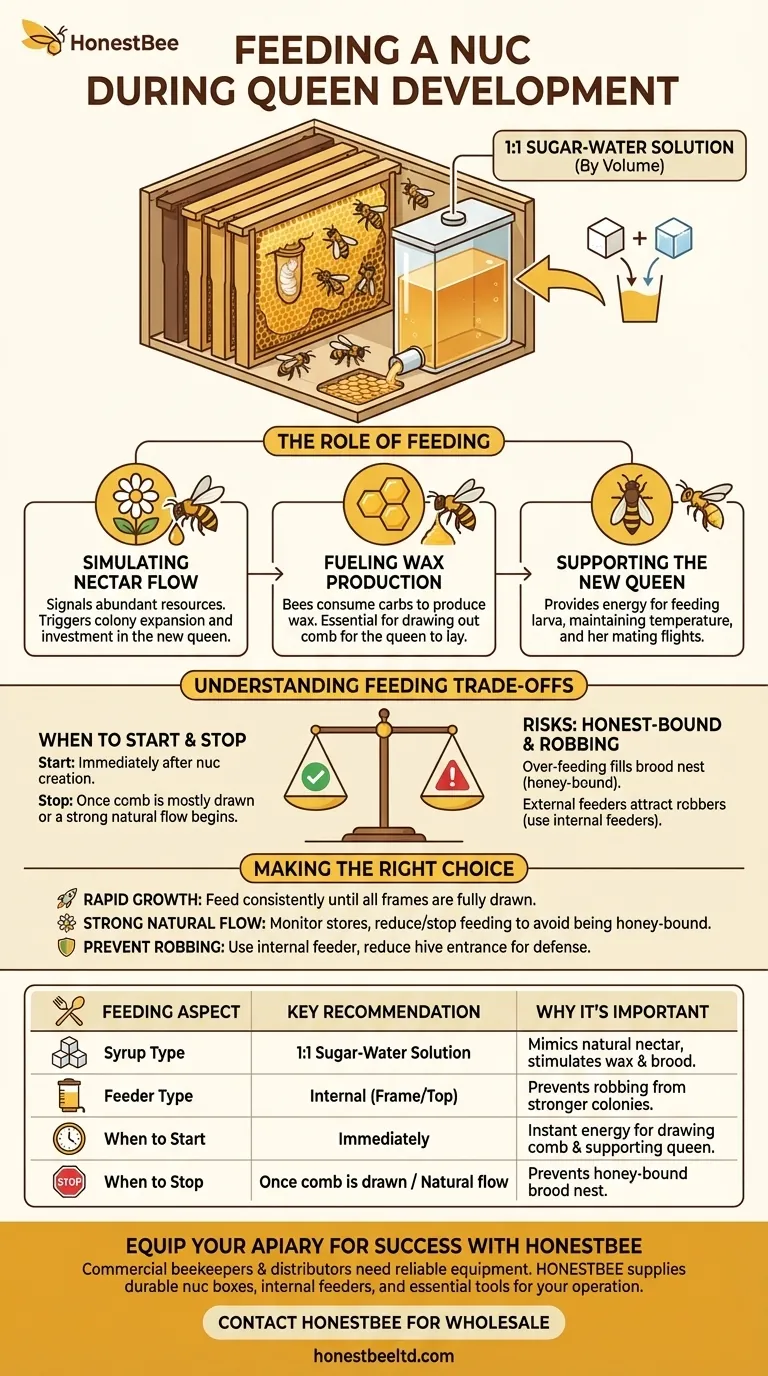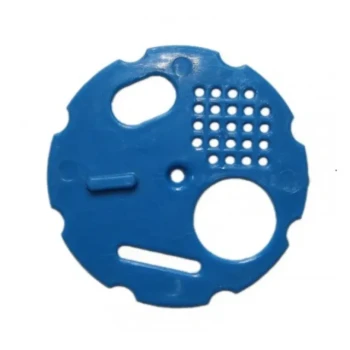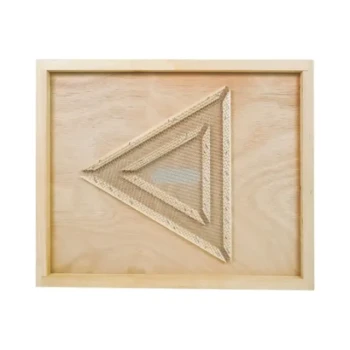To support a developing queen, a nucleus colony (nuc) should be consistently fed a 1:1 sugar-water solution, mixed by volume. This feeding acts as a crucial stimulant, mimicking a natural nectar flow that encourages the bees to build comb and raise brood. You should continue this feeding until the colony has drawn out its comb and a reliable natural nectar flow is available in the environment.
Feeding a queen-rearing nuc isn't just about preventing starvation; it's about simulating a resource-rich environment. This stimulus is the signal the colony needs to invest energy in drawing comb, supporting the new queen on her mating flights, and preparing space for her to lay eggs.

The Role of Feeding in Nuc Development
A nuc raising a new queen is in a uniquely vulnerable and energy-intensive phase. Your feeding strategy directly impacts its chances of success.
Simulating a Nectar Flow
A 1:1 sugar syrup has a consistency similar to natural flower nectar. Providing this signals to the bees that resources are abundant.
This "artificial nectar flow" triggers key behaviors, telling the colony it is a good time to expand, build, and invest in the next generation—starting with their new queen.
Fueling Wax Production
A new nuc's first and most critical job is to "draw out" comb on the frames. Bees must consume large amounts of carbohydrates (sugar) to produce beeswax from their own bodies.
Without a steady food source, wax production will be slow or non-existent, leaving the new queen with nowhere to lay eggs once she has successfully mated.
Supporting the New Queen's Journey
The colony requires significant energy to feed the developing queen larva, keep the queen cell at the right temperature, and support the virgin queen as she emerges.
The virgin queen herself needs energy for her orientation and mating flights. Consistent feeding ensures the entire colony is strong and ready to support her the moment she returns to begin her essential role.
Understanding the Feeding Trade-offs
While feeding is critical, it must be managed correctly to avoid creating new problems. Understanding the balance between support and over-saturation is key.
When to Start and Stop
You should begin feeding the nuc immediately after its creation. The colony's work starts right away, and there should be no delay in providing resources.
Stop feeding once the bees have drawn out most of the comb on their frames. You can also taper off feeding if you observe a strong, natural nectar flow in your area.
The Risk of a "Honey-Bound" Brood Nest
The most common mistake is over-feeding after the comb is built. If you continue providing syrup, the bees may fill the brood cells with it.
This leaves no room for the queen to lay her eggs, effectively halting colony growth. This is known as becoming "honey-bound" or "syrup-bound."
Preventing Robbing
A small, weak nuc is a prime target for robbing by stronger, nearby colonies. An external entrance feeder can attract these robbers and lead to the nuc's destruction.
It is highly advisable to use an internal feeder, such as a frame feeder or a top feeder, to keep the syrup secure within the hive. Reducing the nuc's entrance also helps its guard bees defend their home.
Making the Right Choice for Your Nuc
Your feeding strategy should adapt to your specific goals and environmental conditions.
- If your primary focus is rapid growth: Feed 1:1 syrup consistently until all frames in the nuc box are fully drawn with comb.
- If your area has a strong natural nectar flow: Monitor the nuc's stores carefully and be prepared to reduce or stop feeding to avoid making the brood nest honey-bound.
- If you are concerned about robbing from other hives: Use an internal feeder and reduce the hive entrance to a small opening that the nuc's population can easily defend.
By providing consistent resources and managing them wisely, you give your new queen and her colony the best possible foundation for success.
Summary Table:
| Feeding Aspect | Key Recommendation | Why It's Important |
|---|---|---|
| Syrup Type | 1:1 Sugar-Water Solution | Mimics natural nectar, stimulates wax production and brood rearing. |
| Feeder Type | Internal (Frame or Top Feeder) | Prevents robbing from stronger colonies. |
| When to Start | Immediately after nuc creation | Provides instant energy for drawing comb and supporting the queen. |
| When to Stop | Once comb is drawn or a strong natural flow begins | Prevents the brood nest from becoming honey-bound. |
Equip your apiary for success with HONESTBEE.
As a commercial beekeeper or distributor, the foundation of your operation is strong, productive colonies. Proper feeding is just one part of the equation; having the right, reliable equipment is another.
HONESTBEE supplies the durable, high-quality beekeeping supplies and equipment you need to manage your nucs and full-scale apiaries efficiently. From nuc boxes and internal feeders to essential hive tools, we support your growth through our wholesale-focused operations.
Let's build stronger colonies together. Contact HONESTBEE today to discuss your equipment needs and wholesale pricing.
Visual Guide

Related Products
- HONESTBEE Entrance Bee Feeder Professional Hive Nutrition Solution for Beekeeping
- Rapid Bee Feeder White Plastic 2L Round Top Feeder for 8 or 10-Frame Bee Hives
- HONESTBEE Professional Entrance Bee Feeder Hive Nutrition Solution
- HONESTBEE Round Hive Top Bee Feeder for Syrup
- Professional Hive Front Entrance Bee Feeder
People Also Ask
- How is the mesh ladder and barrier installed in the feeder box? A Step-by-Step Guide to Prevent Bee Drowning
- What are the common types of honey bee feeders? Choose the Right Feeder for Your Hive
- How does the entrance feeder method work? A Guide to Simple But Risky Hive Feeding
- How do you make an entrance feeder for bees? A Guide to Safe & Effective Hive Feeding
- Are entrance feeders good for bees? Prioritize Hive Health Over Convenience



















